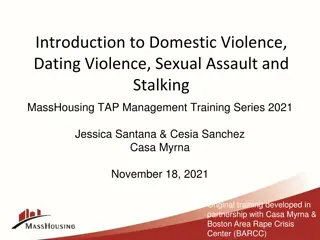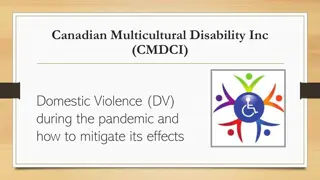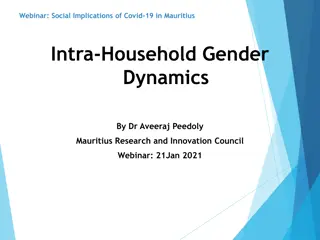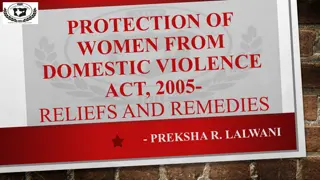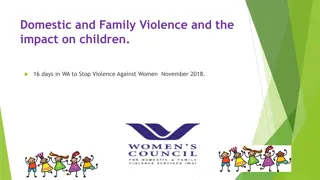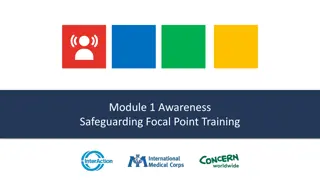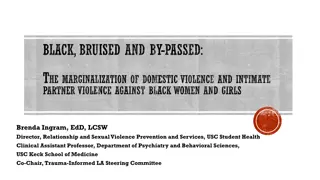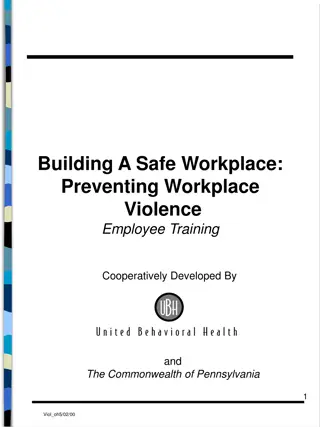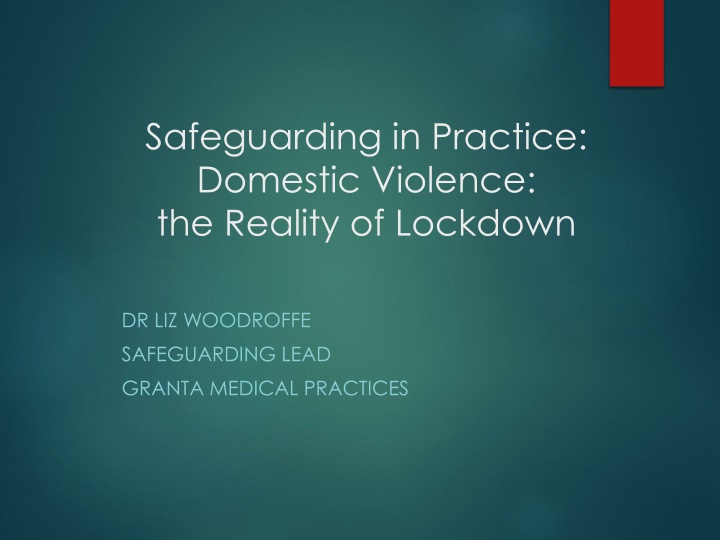
Domestic Violence in Lockdown: Safeguarding Practices and Realities
Explore the impact of lockdown on domestic violence, learn about the alarming statistics, and discover ways to identify and address cases in primary care settings. This webinar provides insights, case scenarios, and practical strategies for healthcare professionals to support victims and combat domestic abuse effectively.
Download Presentation

Please find below an Image/Link to download the presentation.
The content on the website is provided AS IS for your information and personal use only. It may not be sold, licensed, or shared on other websites without obtaining consent from the author. If you encounter any issues during the download, it is possible that the publisher has removed the file from their server.
You are allowed to download the files provided on this website for personal or commercial use, subject to the condition that they are used lawfully. All files are the property of their respective owners.
The content on the website is provided AS IS for your information and personal use only. It may not be sold, licensed, or shared on other websites without obtaining consent from the author.
E N D
Presentation Transcript
Safeguarding in Practice: Domestic Violence: the Reality of Lockdown DR LIZ WOODROFFE SAFEGUARDING LEAD GRANTA MEDICAL PRACTICES
A few webinar ground rules Stay muted by default Please do type questions into Zoom chat section as we go. Opportunity for these to be answered either as we go or later on. Breakout 1 trial run 2 mins Download cases off chat Introductions Find www.menti.com on mobile Recognition of emotional content and importance of peer support
Webinar Plan Introduction + breakout room trial (5 mins) Domestic Abuse and the Reality of Lockdown (5 mins) Reflect on 2 Primary Care case-scenarios using break-out rooms and plenary (40 mins) GP applications: Changes to practice / audit ideas (5 mins) Welcome to stay on after webinar for 10mins to ask any other questions
Learning Objectives Be alert to cues suggestive of domestic violence and barriers in presenting inside and outside covid Consider consultation techniques to help overcome these barriers Apply knowledge and skills to primary care case scenarios Consider changes to practice and primary care audit ideas
Domestic Abuse the problem 1 in 4 women has experienced at least one incident of domestic violence since age 16 (1 in 6 in past year) On average a woman will experience 35 assaults before going to the police 2 women a week in UK are killed by their current or former partner 1 in 7 males will experience domestic violence over lifetime 1 in 4 lesbian, gay, bisexual and transgender people have experienced DV Disabled women are twice as likely to experience domestic abuse than non-disabled women and tend to suffer more severe injuries Domestic violence and abuse in teen relationships is increasingly recognised as a serious issue
Domestic Abuse in the Lockdown 50% increase in calls to Refuge UK helpline 47% increase in victims reaching out via domestic abuse app, Bright Sky. Rise in domestic homicide 16 deaths during 1st2 months of lockdown (compared to 5 nationally over the same period last year) 25% more calls after the start of the Covid-19 lockdown to helpline for perpetrators of domestic abuse seeking help Government pledged 76 million - community-based services that work with victims of domestic abuse, sexual violence and modern slavery, as well as vulnerable children, in England and Wales. Rise in mental health problems and alcohol misuse Child Sexual Exploitation (CSE) and Grooming - online presence and isolation at home
How can we better identify the hidden ? Pre-webinar You Tube video Reluctant Disclosure Watch 3-4 mins of the video again www.menti.com CODE 7463895 What are the barriers to disclosure of domestic violence in this lady? 3 responses each into mentimeter during video
Video: Barriers to Disclosure Coercion and control: jealous person , If I m not home he ll worry need to be back by 4pm , I work out a lot husband wants to keep me in shape Emotional abuse: he wants our relationship to work , he loves me , accusations of her unfaithfulness, guilt, he didn t mean to, my fault , flattery Long-standing: Always been like this Has normalised husband s behaviour and makes excuses to justify it: Sometimes he gets mad and takes it out on me it s OK new boss at work , stress Self blame and low self esteem: my fault lost track of time , she is problem in relationship Fear of worsening: That would really set him off he doesn t like the police Reluctance to leave family home: Really not something I need to leave home on Likely impact on children
Wider Barriers Patient vs Clinician factors Clinician Patient Not asked Fear Never alone with anyone they could tell Cultural shame, stigma Learning disability Rushed clinician Coercion and control Poor communication Emotional and mental health Lack of validation - fear of not being believed especially if no physical evidence / perception that experience not serious enough Financial Dependents Not recognising it as abuse / normalising behaviour
Coercion and Control That attitude of why don t you just leave? I got from my doctor really isn t helpful; abusers grind you down over time so you really believe you can t cope without them. Where do you go? He s telling you he will kill you if you go. Coercive control is an act or a pattern of acts of assault, threats, humiliation and intimidation or other abuse that is used to harm, punish, or frighten their victim the victim becomes captive in an unreal world created by the abuser, entrapped in a world of confusion, contradiction and fear. One study found that 95% of domestic abuse survivors reported experiencing coercive control. (Kelly et al, 2014)
Examples of Coercive behaviour Isolation from friends and family Deprivation of basic needs eg. food Monitoring via online communication tools or spyware Taking control over aspects of everyday life eg. where they can go, who they can see, what they can wear and when they can sleep Depriving access to support services, including medical services Repeatedly putting them down, eg implying they are worthless / at fault Humiliating, degrading or dehumanising them Controlling finances Making threats or intimidating
Breakout 2 Two Questions to consider: What techniques did the doctor use in the video to overcome the patient s barriers to disclosing DV? 1. Thinking about this consultation and other patients you have seen in practice, what risk factors / clues raise your antenna to possible DV in a patient? 2.
Welcome back Comments / Questions in CHAT As we discuss the case, please do share nuggets from your group s discussion into chat What techniques did the doctor use in the video to overcome the patient s barriers to disclosing DV? 1. Thinking about this consultation and other patients you have seen in practice, what risk factors / clues raise your antenna to possible DV in a patient? 2.
Techniques Direct routine question Clinician persistence when clues came Picks up on physical cues + body language Point out inconsistencies in story in factual but non- judgemental way Use patient s words to frame follow-up questions eg. stress at work, but not OK to take it out on you Encouraging It s an OK place to tell Reassuring + validating: not OK to hurt you, not your fault Safety-planning Open door to speak again / signpost to resources
What risk factors and clues should alert us to possible DV? Be professionally curious Triad of safeguarding concern - DV, alcohol misuse and mental health Mental health - Women who experience DV are x3 mental illness Reception : Frequent attender, poor self-care, frequent DNAs, difficult to contact, mobile answered by someone else, cancelling appointments esp at short notice, hypervigilance, fearful, low self esteem, self-discharge, intrusive other person attending appointments
Clinical: Patient: Frequent appointments with vague / medically- unexplained symptoms, poor concentration, chronic pelvic pain, recurrent UTIs, STIs, poorly controlled asthma / diabetes / LTMC, fibromyalgia, chronic fatigue, depression, post-traumatic stress disorder (PTSD), substance misuse, alcoholism, unplanned pregnancies, multiple or inconsistent injuries vague or implausible explanations, headaches, delayed antenatal care, premature labours, stillbirths, sleep problems Relative: attends with patient seemingly unnecessarily, patient is submissive or afraid to speak in front of them, intrusive, aggressive, dominant or over attentive, talking for the patient or refusing to leave the room, age difference
Cultural factors DA under-reported by black and ethnic minority communities: language barriers family or the group s honour, shame and stigma fear of confidentiality being broken immigration status and no recourse to public funding racism perceived or actual cultural beliefs and practices fear of rejection by their community misunderstandings of forced marriage and FGM more than one perpetrator in the family or community fear of honour-based violence. Do not underestimate that perpetrators of honour-based violence can kill close relatives and/or others for what might seem a cultural transgression.
Learning Difficulties Individuals with learning disabilities often vulnerable to being abused in and may endure abuse for longer because: Reliance on their abuser (often their partner) for personal care Have low self-esteem and lack confidence Be socially isolated Natural desire for companionship and intimacy, but lack opportunities to meet people risk of predatory men, as they may fear it is their only chance of a relationship. Lack the knowledge about how to leave an abusive relationship, where to go, sources of support, advice on how to safely leave a violent relationship They may fear having their children taken away if they report domestic violence This is a very real fear and evidence suggest it is not unfounded.
Phone consultations: Asking the question Do they feel safe at home? Who else is listening? Yes / No Questions, reassure confidential Never ask about DV in the presence of another family member, friend, or child over the age of 2 years Use an appropriate professional interpreter (never a family member). The Silent Solution 999 on mobile, option 55
Taking Action Child behind the parent, Parent behind the child DASH Risk Assessment questionnaire: https://www.cambsdasv.org.uk/website/referral_forms/2961 36 If high risk refer to Cambridgeshire and Peterborough IDVA Team MARAC weekly meetings remotely for high risk DASH referrals (score >17, 14-16 also discussed) Home Office campaign - Twitter hashtag #YouAreNotAlone National Domestic Abuse Helpline 0808 2000 247 Cambridge Women s Aid Refuge 01223 460947 http://cambridgewa.org.uk/ Practice MDT
DV Training 30 minute local e-learning from Cambridge IDVA Partnership https://www.cambsdasv.org.uk/website/elearning_modules/ 92616 Safelives Training https://safelives.org.uk/training/frontline-domestic-abuse- practitioners Useful document on older age domestic abuse https://safelives.org.uk/sites/default/files/resources/Safe%20Later %20Lives%20- %20Older%20people%20and%20domestic%20abuse.pdf Helpful document: Domestic abuse: a resource for health professionals. March 2017 https://www.gov.uk/government/publications/domestic- abuse-a-resource-for-health-professionals Adolescent against parent domestic violence excellent resource for parents http://www.domesticabuseservices.org.uk/Adolescent%20vi olence%20to%20parents%20Feb%202016-1.pdf
One thing Type into chat 1 thing you will do differently back your practice or that your practice should reflect upon
Domestic Abuse in Older Adults Around 200,000 older people (aged 66 and older) experienced domestic abuse last year Older victims experience abuse for twice as long before seeking help as those aged under 60 and nearly half have a disability One in four (23%) victims of recorded domestic homicides are over the age of 60 Sources of abuse 51% partner 49% family member 5% close friend 13% care worker Older women were more likely to experience maltreatment than men (3.8% of women and 1.1% of men in the past year) Men were more often the perpetrators except in financial abuse, where the gender ratios were similar.
Under-recognition of Domestic Abuse in the Elderly Safer Lives Insights data 2016 Only 9% of older domestic abuse clients are referred through health routes, which is surprising when those aged 61+ are statistically more likely than younger victims to report poor physical health (11% compared with 3% of those under 61) and to have visited their GP in the past 12 months (53% compared to 46% of those under 61)
Case 2 FD is an 85 year old gentleman with Alzheimers Disease who lives with his wife. Carers three times daily + cleaner weekly. Wife has COPD, overweight. FD is unstable on his feet, bruise on his leg where he fell over his wife s wheelchair on the way to toilet. Pharmacy noticed that medications are being under-ordered. Cleaner calls practice concerned that his wife has angry outbursts. Flap laceration noted on right hand by district nurses. Wife told them it happened when she was trying to get him up to go to toilet. Women s new shoes and clothing noted arriving in flat by mail order. FD s clothes are worn and trousers stained. Wife has financial power of attorney and health and welfare.
What may be the barriers to this gentleman speaking out about domestic abuse? 30 seconds thinking time 30 seconds to type some thoughts into mentimeter www.menti.com CODE: 9512628
Additional barriers to identification of Older Age Domestic Abuse Dependency issues less likely to speak out, easier to control, signs may be subtle Eg. Repeated admissions with urinary tract infections because she was so dehydrated Wish to remain at home, abuse more likely to be normalised and long-standing Health problems, reduced mobility or other disabilities prevent disclosure Need for home visit to assess Patient aggression eg. in setting of dementia Generational, cultural and religious attitudes to relationships guilt in leaving Isolation, less able to connect with friends or have friends independent of perpetrator
Breakout 3 Two Questions to consider: Is this gentleman an adult at risk ? What other information would you like to know? 1. When managing similar patients in your practice, what organisations / resources have you called upon? 2.
Definition of Adult at RIsk What is a vulnerable adult or adult at risk ? Care Act 2014: Aged 18 years or over and: has needs for care and support (whether or not the local council is meeting any of those needs) and; 1. is experiencing, or at risk of, abuse or neglect; and 2. as a result of those care and support needs is unable to protect themselves from either the risk of, or the experience of abuse or neglect. 3. NB. Not all patients with vulnerabilities meet this definition. Consider whether patient has ability to leave a risky situation? Effects of coercion / control?
Concerns Capacity in setting of dementia Is he an Adult at risk ? (previously vulnerable adult) Safety at home accidental injuries, safety mobilising toilet to bed, adequacy of current care package Concerns re wife s carer role and whether her actions are in FD s best interest Reason for under-ordering of medications Ability to cope / assess and provide for FD s needs Reason for angry outbursts ?carer fatigue ?mental health ?emotional abuse Recent hand injury ?intentional ?physical abuse Contrast in clothing ?financial abuse ?neglect Wife s physical health Wife s capacity
What else would you like to know? FD s wishes regarding place of care FD s physical health ?cause for poor mobility FD s mental state Night time safety, bed position and wandering Self care and continence how does wife deal with accidents when carers not there? Mobility OT / physio assessment Weight and food intake Financial situation Any concerns from other care-givers carers or family members
How could we act? Adult Safeguarding Referral Consider IMCA lack of capacity and concerns regarding what constitutes best interest Case may need to be taken to Court of Protection given concerns + wife POA Consider urgent respite care to enable carer break and further assessments regarding wishes, mobility and safety at home Falls assessment + medication review MDT case-review meeting +/- social care
Best interest What are the available options? Who is the decision-maker? Who has been consulted? How have you involved the patient? What factors relating to the patient have been considered? Where has the Best Interest decision making process been recorded?
IMCA A specific type of advocate that has to be involved if a person who lacks capacity has no one else to support them Not the decision-maker, but the decision-maker has a duty to take into account information given by IMCA. An IMCA can only be involved if: decision is about serious medical treatment on NHS person to be moved into long-term care of more than 28 days in a hospital or 8 weeks in a care home care reviews about accommodation or changes to accommodation adult protection cases (even if the person who lacks capacity has family and/or friends) Locally commissioned service: www.voiceability.org/ Online referral
One thing Type into chat one thing that has struck you or will have impact on your practice
Challenges and changes to practice Emotional support for new mums, proactive 8 week checks, promote remote networks, attachment. ICON. Proactive telephone follow-up - pre-existing mental health concerns esp. perinatal, adolescent, socially isolated Review your adult safeguarding register Do all your vulnerable adults meet the definition of Adult at Risk under the Care Act 2014? Do you need an additional code to highlight soft concerns ? How are DASH reports followed up in your practice? Do you have a robust system in place for actioning these?
Audit Ideas Follow-up patients identified as high risk from an audit of the triad of concern Eg. patients with DV, alcohol and MH codes (12 patients) Audit patients with multiple DNAs targeting those with a triad risk factor ?coercion + control X3 DNA this year + DV = 32 patients X3 DNA + MH = 26 patients X3 DNA + alcohol misuse = 19 patients Audit your domestic violence coding 4-8% DV prevalence (Granta 1%). Consider reasons why difference.

